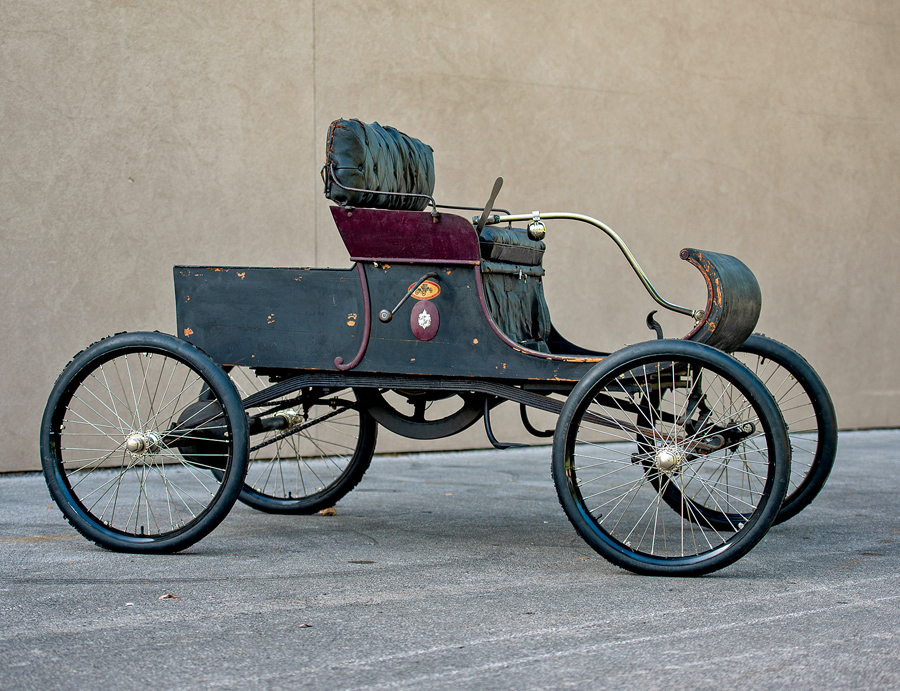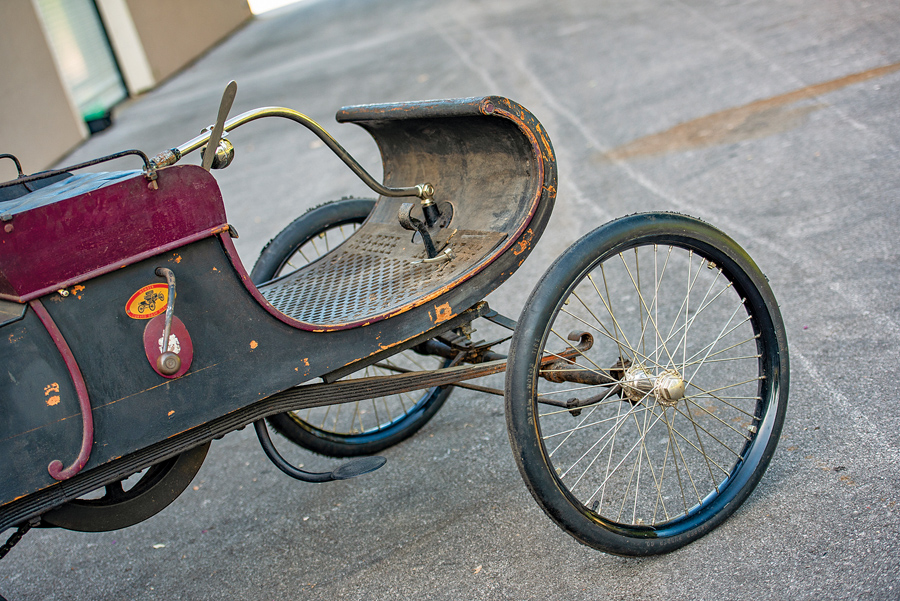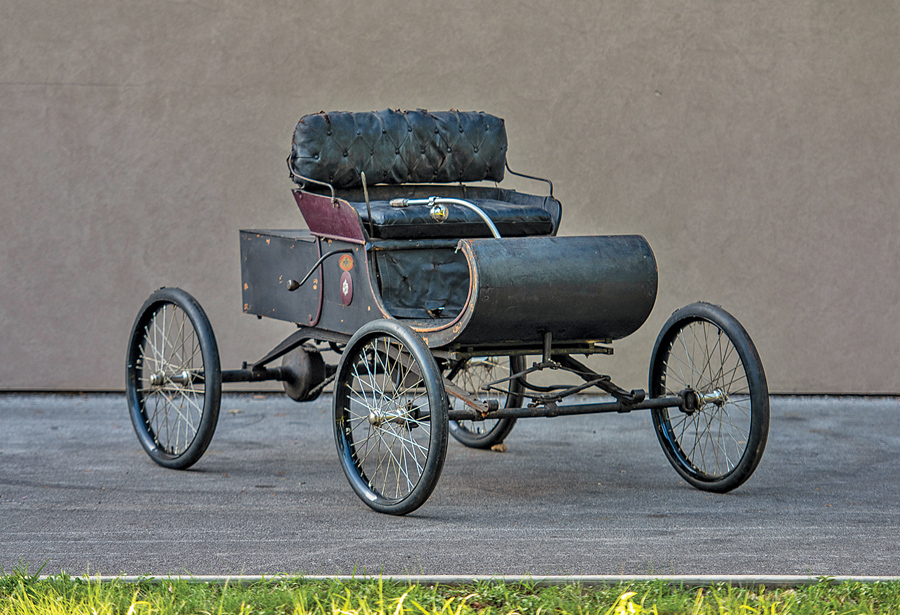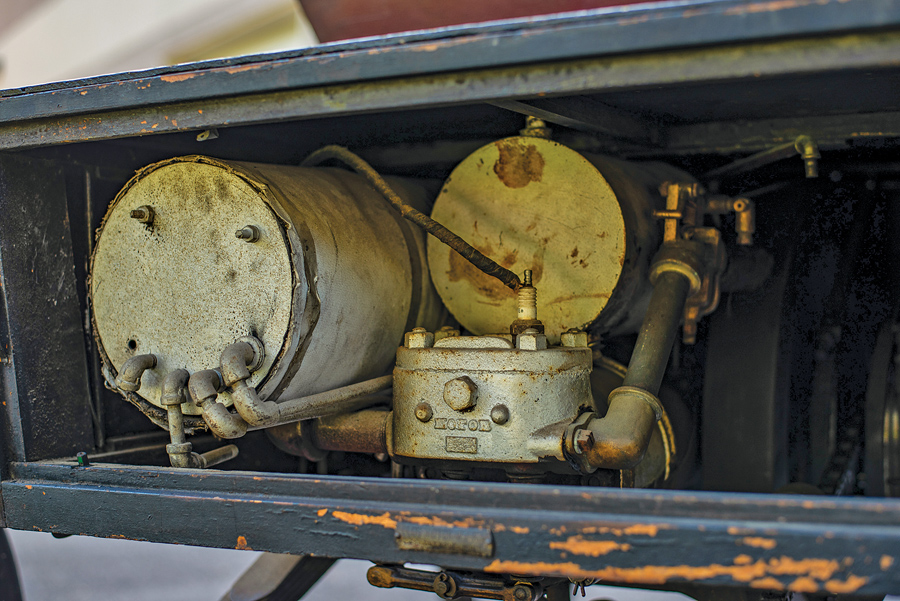- Offered from the Richard L. Burdick Collection
- Owned by only two families since new
- Wonderful preservation throughout, including paint and upholstery
- Dated as a 1901 by the Veteran Motor Car Club of Great Britain
- Ideal for the Antique Automobile Club of America Historic Preservation of Original Features class
SCM Analysis
Detailing
| Vehicle: | 1901 Oldsmobile Model R “Curved Dash” Runabout |
| Years Produced: | 1901–06 |
| Number Produced: | 12,433 |
| Original List Price: | $650 |
| SCM Valuation: | $55,000 |
| Tune Up Cost: | $450 |
| Chassis Number Location: | Patent plate on body and on the compression-release pedal |
| Engine Number Location: | Pad on outboard-facing side of the cylinder head |
| Club Info: | Curved Dash Oldsmobile Club |
| Website: | http://www.curveddasholdsmobileclub.com |
| Alternatives: | 1903–04 Ford Model A, 1907–15 International Harvester high-wheelers, 1908–16 Ford Model T |
| Investment Grade: | B |
This car, Lot 210, sold for $40,700, including buyer’s premium, at RM Sotheby’s auction in Hershey, PA, on October 12, 2018.
While the Olds Motor Vehicle Company was formed on August 21, 1897, the company didn’t produce its first series production car until 1901.
While up to 11 different models were planned, a fire at the Detroit factory spared only the smallest model — what eventually became known as the Curved Dash Oldsmobile (better known in enthusiast circles as a CDO).
Olds used a factory in Lansing, MI, to start production by the late summer of 1901, and a total of 450 examples of this introductory-year-only model R were built.
By the end of CDO production (through 1906), an estimated 12,433 examples were made.
Exit Ransom Olds
During 1906, a “straight dash” front fascia was available, with that configuration the only car that carried the torch for a single-cylinder Oldsmobile through the end of 1907.
With the success of the CDO, Oldsmobile’s model range started increasing in 1905, with a 2-cylinder Side Entrance Touring added to the line.
By 1908, the model line had expanded to four, powered with 4- and 6-cylinder engines. These models were not to founder Ransom Eli Olds’ liking, so he left the company — which the board of directors had taken over anyway — in 1904.
Yet in 1908, the board sold out to William C. Durant to become part of his fledgling General Motors, of which Oldsmobile would remain a key part for 96 years.
In a way, Ransom Olds did get the last laugh. Shortly after he left his namesake company, other financial backers approached him in Lansing, and they stared the Reo Motor Company.
While Reo built cars until 1936, it was with trucks that they became a major independent manufacturer — until White Motors absorbed them in 1957. Also, in a form of poetic justice to Ransom and the CDO, the last Oldsmobile GM built in 2004 was the smallest model from that final year — an Alero (and thankfully, not an Olds Bravada SUV).
America’s first mass-market vehicle and cult car
The CDO car caught on well with the public. The car was unique, as it wasn’t priced in the thousands of dollars and marketed to the wealthy as an elitist toy.
While its $650 price tag was not chump change in 1904, it was certainly within reach of business professionals — and even the middle class of the time.
The car’s simple, single-cylinder engine was quite robust. The 2-speed planetary transmission was easy to operate, and its compact size and somewhat tall ride height served well on the streets and crude roads of the time.
Folks seeing the local doctor making house calls in a Curved Dash helped the masses realize that these new contraptions had a useful purpose. This opened the gates for acceptance of other lower-priced models to come, such as the Buick Model 10 and the Ford Model T.
The start of car culture
The CDO models were the first cars to be a part of popular culture. Check out the 1905 song “In My Merry Oldsmobile” by Gus Edwards and Vincent Bryan. Indeed, the picture in most people’s minds of a horseless carriage is that of a Curved Dash Olds.
In the dawning years of preserving old cars in the pre-World War II era (the Antique Auto Club of America was formed in 1935), early collectors sought out the CDO.
Some of these durable, well-liked cars were still on the road during the Great Depression of the 1930s. Curved Dash Olds that had been parked when their owners moved up to more-modern cars had been sitting in barns and carriage houses for a decade or two before the Great Depression pressed them back into service. It wasn’t a major challenge to get running again, as the 1930s were a time when folks tended to be tinkerers.
After World War II, the car’s simple construction (compared to a then-current production Oldsmobile) made it a member of the society of cars that have been made into replicas. The vast majority of what are billed as a “Curved Dash Olds” these days are today actually replicas created more than five decades ago. Actual CDOs now rarely publicly trade hands, which makes our featured car that much more special.
A three-owner, 117-year-old artifact
The fascinating tale of Victor F. Hitz winning the car as a 5-year-old boy — and then keeping it for the rest of his life — makes our subject car famous in CDO enthusiast circles.
However, it’s impossible to positively read the serial number in the three places it was stamped. That does seem a bit odd for a car with such strong provenance.
The listed number in RM Sotheby’s catalog states 6541 (likely the cylinder-head number), which would date it as 1902 production.
The unique nuances of the first-year model R make it easy to confirm our car as such, especially when compared to later models 6C, B and F.
However, it’s possible that Mr. Hitz replaced the cylinder head decades past, back when petty things like “matching numbers” meant nothing compared to keeping a car running.
The photos of the stamping pad on the head show that corrosion has made the number all but illegible to the naked eye, and the patent plate seems to have been separated from the car for quite some time.
Perhaps the new owner will utilize non-destructive forensic means to find a number in the remaining location where it should be found.
As this car was a promotion at the in-period Chicago Auto Show, there could be prototype components on it that may not have been serialized.
Please don’t restore this car
As there were so few changes made to this car over the past century and change, its originality makes it outstanding for any pre-war vehicle — especially from the first production run of a car as iconic as a CDO.
This is a car that should only see regular service to keep it operable and otherwise be kept exactly as it is.
While some can make the argument that it deserves to be retired as a preserved static historic artifact that can be a guide to restoring other examples, others can just as easily make the argument that it should be maintained and used on a limited basis for events such as the London to Brighton Veteran Car Run.
I wouldn’t even attempt to touch up the areas where the paint has chipped from age and use. Even if you used spectrographic analysis to match the paint, the new paint wouldn’t match up well to the original.
Besides, this car is hardly distressed for being 117 years old. It wears its patina as a badge of honor. It escaped the era of restoration for the sake of just making it pretty. It indeed is a true artifact of history, and as such, was well bought. ♦
(Introductory description courtesy of RM Sotheby’s.)



